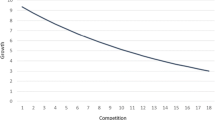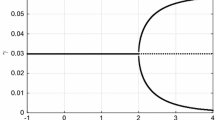Abstract
Fiscal and monetary institutions are conspicuously omitted in the conventional theory of long-run economic growth. Moving from the Schumpeterian entrepreneur, who adopts new technology because its value, according to Tobin’s q, dominates the economic rents of existing capital, we argue that the Schumpeterian entrepreneur’s incentives to innovate change when he is transplanted into the public economy. We analyze two alternative institutional settings denoted as “long chain” and “short chain”. Through the “long chain” model we show that the Schumpeterian entrepreneur is driven towards “destructive creation” of new capital, thus becoming a political dis-entrepreneur, while the quasi-contractual “short chain” model provides incentives to innovate.
Similar content being viewed by others
References
Acemoglu, D. (2006). A simple model of inefficient institutions. Scandinavian Journal of Economics, 108, 515–546.
Acemoglu, D., & Johnson, S. (2005). Unbundling institutions. Journal of Political Economy, 113, 949–995.
Acemoglu, D., Johnson, S., & Robinson, J. A. (2001). The colonial origins of comparative development: an empirical investigation. American Economic Review, 91, 1369–1401.
Barone, E. (1908). Il ministro della produzione nello stato collettivista. Giornale degli Economisti, 9, 267–293.
Barro, R. J. (1974). Are government bonds net wealth? Journal of Political Economy, 82, 1095–1117.
Barro, R. J. (1976). Rational expectations and the role of monetary policy. Journal of Monetary Economics, 2, 1–32.
Barro, R. J. (1989). The Ricardian approach to budget deficits. Journal of Economic Perspectives, 3, 37–54.
Barro, R. J. (1990). Government spending in a simple model of endogenous growth. Journal of Political Economy, 98, S103–125.
Barro, R. J., & Sala-i-Martin, X. (1995). Economic growth. Sydney: McGraw–Hill.
Baumol, W. J. (1959). Business behavior, value and growth. New York: Macmillan.
Blanchard, O., & Fischer, S. (1990). Lectures on macroeconomics. Cambridge: MIT Press.
Brennan, G., & Lomasky, L. (1993). Democracy and decision. The pure theory of electoral preference. Cambridge: Cambridge University Press.
Brennan, G., & Eusepi, G. (2004). Fiscal constitutionalism. In R. E. Wagner & J. Backhaus (Eds.), Handbook of public finance (pp. 53–76). Boston: Kluwer Academic.
Buchanan, J. M. (1960). La scienza delle finanze: The Italian tradition in fiscal theory. In J. M. Buchanan (Ed.), Fiscal theory and political economy. Selected essays (pp. 24–74). Chapel Hill: The University of North Carolina Press.
Buchanan, J. M. (1969). Cost and choice. An inquiry in economic theory. Chicago: Markham.
Buchanan, J. M. (1975). The limits of liberty—between anarchy and Leviathan. Chicago: Chicago University Press.
Buchanan, J. M. (1976). Barro on the Ricardian equivalence theorem. Journal of Political Economy, 84, 337–342.
Chang, K. H., de Figueredo, R. J. P. Jr., & Weingast, B. R. (2001). Rational choice theories of bureaucratic control and performance. In W. F. Shughart II & L. Razzolini (Eds.), The Elgar companion to public choice (pp. 271–292). Cheltenham: Edward Elgar.
De Viti de Marco, A. (1936). First principles of public finance. New York: Harcourt Brace. Translated from the Italian by Edith Pavlo Marget.
Eggertsson, T. (1990). Economic behavior and institutions. Cambridge: Cambridge University Press.
Eusepi, G. (2000). Contractual fiscal equivalence versus geographical fiscal equivalence. Public Choice, 104, 309–317.
Eusepi, G. (2006). Public finance and welfare: from the ignorance of the veil to the veil of ignorance. Journal of Economic Behavior and Organization, 59, 460–477.
Garnaut, R., & Fitzgerald, V. (2002). Review of Commonwealth-state funding final report, August.
Jones, P. R. (1978). The appeal of the political entrepreneur. British Journal of Political Science, 8(4), 498–504.
Kornai, J., Maskin, E., & Roland, G. (2003). Understanding the soft budget constraint. Journal of Economic Literature, 41, 1095–1136.
Montemartini, G. (1902). Municipalizzazione dei pubblici servigi. Milano: Soc. Ed. Libraria.
Niskanen, W. C. (1994). Bureaucracy and public economics. Aldershot: Edward Elgar.
North, D. C. (1990). Institutions, institutional change and economic performance. Cambridge: Cambridge University Press.
North, D. C. (1994). Economic performance through time. American Economic Review, 84, 359–368.
North, D. C. (1997). Cliometrics—forty years later. American Economic Review, 87, 412–414.
North, D. C., & Thomas, R. P. (1973). The rise of the Western world: A new economic history. Cambridge: Cambridge University Press.
Olson, M. (1969). The principle of fiscal equivalence: the division of responsibilities among different levels of government. American Economic Review, 59, 479–487.
Rodrik, D. (2004). Getting institutions right (Mimeo).
Rodrik, D., Subramanian, A., & Trebbi, F. (2004). Institutions rule: the primacy of institutions over geography and integration in economic development. Journal of Economic Growth, 9, 131–165.
Romer, D. (2006). Advanced macroeconomics (3rd edn.). Sydney: McGraw–Hill.
Schumpeter, J. (1939). Business cycles. New York: McGraw–Hill.
Tiebout, C. (1956). A pure theory of local expenditures. Journal of Political Economy, 64(5), 416–424.
Wilson, J. Q. (1980). The politics of regulation. New York: Basic Books.
Wilson, J. Q. (1989). Bureaucracy: What government agencies do and why they do it. New York: Basic Books.
Wilson, E. J., & Chaudhri, D. P. (2000). Endogeneity, knowledge and dynamics of long run capitalist economic growth. Paper presented at the 5th conference on dynamics, economic growth, and international trade, Sapienza University of Rome, Rome, June.
Author information
Authors and Affiliations
Corresponding author
Additional information
The authors are deeply grateful to two anonymous referees for providing insightful comments that have brought greater clarity to the argument. They also thank the Editor in Chief of the journal for patiently reviewing the manuscript. Without his suggestions this paper would not have reached its present form.
Rights and permissions
About this article
Cite this article
Eusepi, G., Wilson, E.J. How to make a dis-entrepreneur of the Schumpeterian entrepreneur: the impact of institutional settings on growth. Public Choice 136, 39–54 (2008). https://doi.org/10.1007/s11127-008-9277-y
Received:
Accepted:
Published:
Issue Date:
DOI: https://doi.org/10.1007/s11127-008-9277-y




